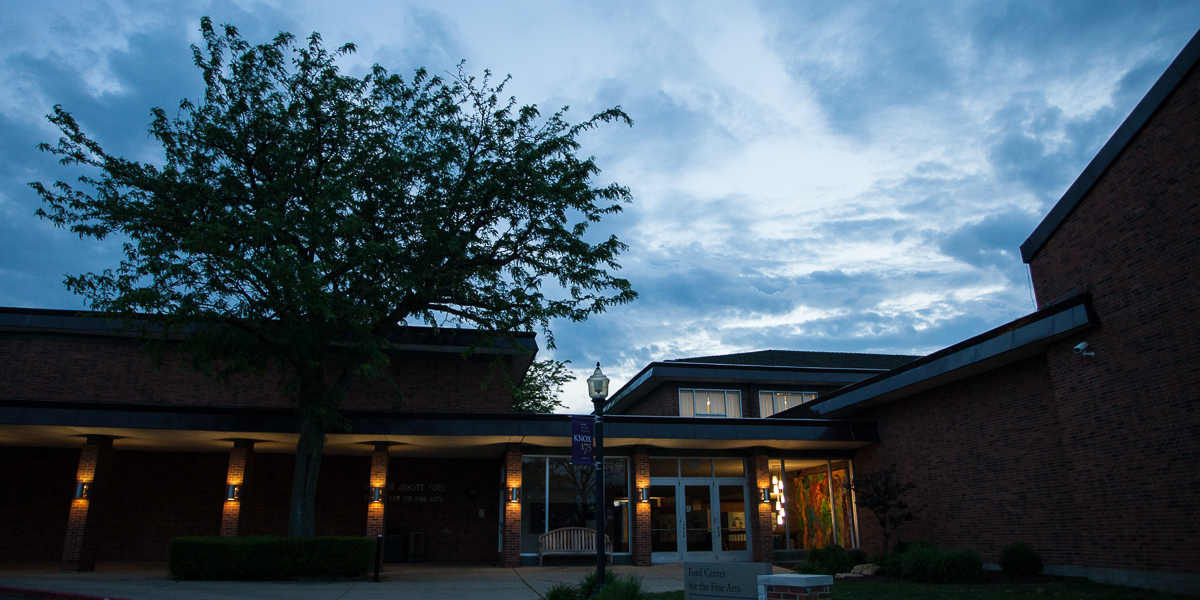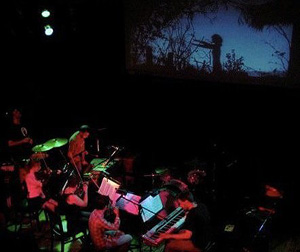

Venture Boldly

Office of Communications
2 East South Street
Galesburg, IL 61401

By Christopher Poore ‘14
If you think silent films are silent, think again. They might not use dialogue, but they do have their own language, and Matt Pace '99 and Matt Frederick '99 are fluent.
That's because both Pace and Frederick have been major players in The Rats and People Motion Picture Orchestra, an ensemble based out of St. Louis, Missouri, that composes and performs original scores to films from both the Silent Era and the more contemporary scene.
"We aren't period fetishists, and we aren't looking to be the center of attention at a live screening," said Frederick. "Our ethic for composition is an attempt at composing music that is timeless and, therefore, complementary to the visual narrative that is being presented to a contemporary audience."
Along with Robert Laptad, Heather Rice, Brien Seyle, and Emma Tiemann, Pace and Frederick have performed original scores for such cinema classics as Buster Keaton's Go West, FW Murnau's Nosferatu, and Sergei Eisenstein's Strike.
"We work with Silent Era films that we find to be current, vital, and relevant to our times," said Frederick. "The pickings are in no way slim."
St. Louis and silent film aren't the only two things that Pace and Frederick share in common. Not so long ago, they shared a dorm room in Jazz House, a structure on the Knox campus given entirely to jazz and the students that make it. Additionally, both Pace and Frederick spent time at the College that proved to be deeply important for their later musical endeavours.
"I admit it," said Pace. "I didn't even really know how to read music when I started at Knox. Hanging out for hours in the practice rooms and taking advantage of the free lessons you get as a music major, I learned tons and tons and tons and tons in a self-guided way. I then learned tons and tons and tons more from my actual music classes."
"Knox talked the talk when it came to interdisciplinary stuff," Pace went on. "My own senior Honors concert was sort of this multimedia music show, and that sort of thing was pretty normal there."
 After graduation, the two former roommates met up in St. Louis, where Pace began to study music composition at Washington University, eventually earning his Ph.D. in music theory. On the side, though, Pace and Frederick played in a band called the Baysayboos, which eventually, through the unravelings and mergings not uncommon in the music world, became the Rats and People. Originally the plan was to play straight "chamber rock," a subgenre that relies more heavily on classical notation, but soon enough, said Pace, "the movie-accompaniment thing kind of ate the rock band, and so we added 'motion picture orchestra' to the name."
After graduation, the two former roommates met up in St. Louis, where Pace began to study music composition at Washington University, eventually earning his Ph.D. in music theory. On the side, though, Pace and Frederick played in a band called the Baysayboos, which eventually, through the unravelings and mergings not uncommon in the music world, became the Rats and People. Originally the plan was to play straight "chamber rock," a subgenre that relies more heavily on classical notation, but soon enough, said Pace, "the movie-accompaniment thing kind of ate the rock band, and so we added 'motion picture orchestra' to the name."
Since then, the ensemble has used traditional orchestra instruments like the violin and trumpet in conjunction with more modern instrumentation, creating a soundtrack that has a tendency to make silent films feel startlingly relevant and accessible.
"When I was in college, I used to make fun of people who felt strongly that there was some timeless quality to art wholly separate from how it was shaped by the accidents of history," said Pace. "But as I have matured musically, my views on art have become a lot more conservative. Now here I am, one of these curmudgeons telling the youngsters that Buster Keaton expressed more in one stone-faced stare into the camera than the entire cast of a modern rom-com does in a whole movie."
As the band continues to produce pieces commissioned by the likes of the St. Louis International Film Festival and perform at places like the St. Louis Classic French Film Festival, both Pace and Frederick look back at their Knox experience to find a model for what a creative community can look like.
"As a musician, I wasn't cabined at Knox," said Frederick. "It was truly a vibrant artistic community that encouraged personal artistic growth wherever that growth may lead a person."
Published on March 29, 2013